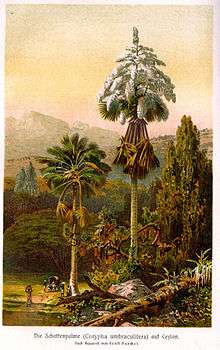Corypha umbraculifera
| Talipot palm | |
|---|---|
| | |
| Talipot palm flowering at Kerala, India | |
| Scientific classification | |
| Kingdom: | Plantae |
| (unranked): | Angiosperms |
| (unranked): | Monocots |
| (unranked): | Commelinids |
| Order: | Arecales |
| Family: | Arecaceae |
| Genus: | Corypha |
| Species: | C. umbraculifera |
| Binomial name | |
| Corypha umbraculifera L. | |
| Synonyms[1] | |
| |
Corypha umbraculifera, the talipot palm, is a species of palm native to eastern and southern India and Sri Lanka. It is also grown in Cambodia, Myanmar, China, Thailand and the Andaman Islands.[2] It is a flowering plant with the largest inflorescence in the world. It lives up to 60 years before bearing fruits and flowers. It dies shortly after.
Description
It is one of the largest palms with individual specimens having reached heights of up to 25 m (82 ft) with stems up to 1.3 m (4.3 ft) in diameter.[3] It is a fan palm (Arecaceae tribe Corypheae), with large, palmate leaves up to 5 m (16 ft) in diameter, with a petiole up to 4 m (13 ft), and up to 130 leaflets.
The talipot palm bears the largest inflorescence of any plant, 6–8 m (20–26 ft) long, consisting of one to several million small flowers borne on a branched stalk that forms at the top of the trunk (the titan arum, Amorphophallus titanum, from the family Araceae, has the largest unbranched inflorescence, and the species Rafflesia arnoldii has the world's largest single flower). The talipot palm is monocarpic, flowering only once, when it is 30 to 80 years old. It takes about a year for the fruit to mature, producing thousands of round, yellow-green fruit 3–4 cm (1–1.5 in) in diameter, each containing a single seed. The plant dies after fruiting.[4][5]
Distribution
The talipot palm is cultivated in South India and Sri Lanka. It is also cultivated in Southeast Asian countries of Cambodia, Myanmar, Thailand and the Andaman Islands. It is also grown sparsely in China.
Uses
Historically, the leaves were written upon in various Southeast Asian cultures using an iron stylus to create palm leaf manuscripts. In the Philippines, it is locally known as buri or buli. The leaves are also used for thatching, and the sap is tapped to make palm wine. In South India, the palm leaves are used to make umbrellas for agricultural workers. The tree is known as kudapana (കുടപ്പന) in Malayalam, talo (/tɑːloʊ/, ତାଳ) in Odia, and kudaipanai (குடைப்பனை) in Tamil, which means umbrella palm.[6] The plant is known as tala (තලා) in Sri Lanka, by local Sinhalese people.
Gallery

 At Lyon Arboretum, Hawaii, U.S.
At Lyon Arboretum, Hawaii, U.S.- At Jardin Botanique de Deshaies, Guadeloupe
 Corypha umbraculifera painting (1913)
Corypha umbraculifera painting (1913) Corypha umbraculifera plant in the garden,SIMS, Anandashram, Kerala,india
Corypha umbraculifera plant in the garden,SIMS, Anandashram, Kerala,india
See also
References
- ↑ The Plant List Corypha umbraculifera
- ↑ Kew World Checklist of Selected Plant Families, Corypha umbraculifera
- ↑ Dominica Botanic Gardens
- ↑ Rafinesque, Constantine Samuel. 1938. Sylva Telluriana. Mantis Synopt. New genera and species of trees and shrubs of North America p 13, Bessia sanguinolenta
- ↑ Linnaeus, Carl von. 1753. Species Plantarum 2: 1187, Corypha umbraculifera
- ↑ Talipot palm in full bloom, FAO reports: tropical palms, palm products, palms with development potential
- Johnson (1998). "Corypha umbraculifera". IUCN Red List of Threatened Species. Version 2006. International Union for Conservation of Nature. Retrieved 12 May 2006.
- PACSOA: Corypha umbraculifera
External links
| Wikimedia Commons has media related to Corypha umbraculifera. |
 "Talipot Palm". New International Encyclopedia. 1905.
"Talipot Palm". New International Encyclopedia. 1905.
